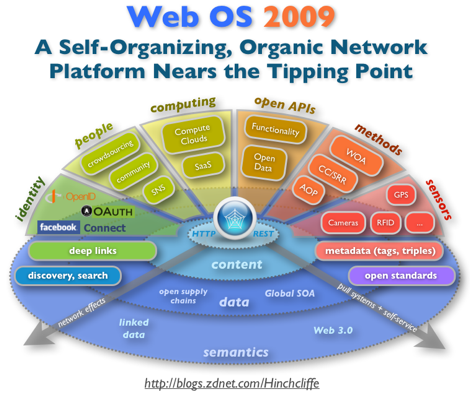How the Web OS has begun to reshape IT and business

These days in the halls of IT departments around the world there is a growing realization that the next wave of outsourcing, things like cloud computing and crowdsourcing, are going to require responses that will forever change the trajectory of their current relationship with the business, or finally cause them to be relegated as a primarily administrative, keep-the-lights-on function.
IT is going to either have to get more strategic to the business or get out of the way. Businesses too must grow a Web DNA. The proximal cause of this seems to be the growing domination of the global network that surrounds all businesses today: The Web. If you've read my writings here since 2006 you largely know what's happening: Today's highly evolved Web has grown far beyond its original roots in content distribution and communication. It has become a fully fledged platform for media (TV, movies, music, newspapers, gaming, etc. have been strongly disrupted by the Web and now largely reside there) as well as more strategic pursuits. Probably most significantly is computing in all its many forms. This ranges from low-level services such as raw compute power and storage to social computing, semantics, and collective intelligence.
But the advent of a Web OS is certainly not just an IT story. It's also -- and really mostly -- a business story. Those who are trying to track the so-called "big shifts" in the 21st century, thinkers like John Hagel, are attempting to pin down the specific changes taking place in the world today. John recently noted that "we are moving from a relatively stable business environment to one characterized by rapid rates of change with ever more disruptions generating increasing uncertainty and unpredictability". In this way, routinely transforming instability and rapid change from a threat (which it is to most businesses today) into opportunity is a core skill that organizations increasingly must be able to cultivate.
That much of the pace of change today is driven by the modern world's pervasive and instant global flows of knowledge is largely due to influence of the Web and its billions of two-way touchpoints with nearly a third of the world's population (including practically all of the developed world). In addition to ultra fast feedback loops that drive real-time action/response scenarios in the marketplace, the Web has also become an incredibly efficient, inexpensive, and easy-to-use delivery system for just about anything that an interface can be wrapped around.

WOA = Web-Oriented Architecture
CC/SRR = Creative Commons/Some Rights Reserved
AOP = Architectures of Participation
It's a world where scarcity practically doesn't exist and access to abundance is virtually free. It's also true that the business models of the Web OS are only emerging as well. While monetization is prevalent for those consuming or participating in the Web OS, there is also a real and ongoing concern that it's also the modern version of sharecropping. That traditional management approaches often don't understand the nuances of these issues and aren't designed to take advantage of this modern economic landscape, much less compete with a growing number of businesses that do, is a whole side story I'll explore when I'm able. But it's one in which the Web OS is increasingly forcing a serious reevaluation of modern business practices as well as the very notion of how an opportunity is defined, identified, and targeted.
What is the Web OS?
While there are multiple ways of looking at the Web as an operating system, from cloud environments that mimic a desktop operating system to sets of services packaged together and bundled as an individual product to companies, the largest -- and the most significant -- is the idea of an overarching and emergent Internet operating system. The data, services, and even communities of the Web are now programmatic and can be incorporated and remixed into any other business or product at will. The concept of a Web OS isn't new. But its arrival on the scene in compelling form with serious impact to the enterprise is.
Over the last few years, as open APIs, social networking platforms, cloud computing, open identity services, sensor-driven databases (such as with GPS and OpenStreetMap), or even people (example: Amazon's Mechanical Turk) have created open ecosystems in which anyone can participate, including business, both to contribute and to consume. The Web has become the ultimate outsourcing platform and one that is incredibly agile too, combined with economies of scale that are very hard to match. There are challenges too: Unpredictabilities and risks exist that must be dealt with both routinely and successfully.
But to perform well in this changing business environment organizations have to move beyond the classical conceptions of partnerships, OEM relationships, and strategic but traditionally static vendor portfolios as they look to either plug into the services in the Web OS or decide to offer up their own businesses as a service within it. Either are highly strategic choices and this is a world where you can connect supply chains or enter in a online partnership as quickly as clicking on the Agree button of an online Terms of Service and adding some (hopefully secure) code to your IT systems.
The Web OS has become a fast moving river of business opportunity as the number of credible services with it has mushroomed in the last 18 months. Having the processes in place to evaluate and exploit this environment to connect with and tap into compute power, infrastructure, software, workers, knowledge, and innovation in time frames that are useful will be one of the signature challenges for traditional businesses seeking to harness what is turning into the richest accessible set of business inputs in history.
While cloud computing is right now probably the strongest trend that's driving attention and awareness of the Web as a self-organizing platform for strategic services (SaaS is right behind it), many of the other elements of the Web OS have not escaped the attention of forward looking business thinkers looking at the future of their organizations and seeking to improve.
Five Web OS Trends for 2009
Here are some of the ways that the emerging Web OS is reshaping IT and business this year:
- Innovation is one of the easiest and least risky areas that can be tapped by most organizations. The ongoing story of market leader Netflix and it's now-famous Netflix Prize contest is a model of how an organization can open up and tap into ideas without interfering with production processes directly, even though the final outcome will drive operational improvements. While Dell, Innocentive, Crowdspring, and others have been doing this for years, only now are we seeing critical mass in more direct and mature examples of Web OS-driven inputs directly driving concrete, specific, and competitive outcomes.
- Vertical and horizontal crowdsourcing models are increasingly viable as 3rd party intermediaries grow in size and experience. Vertical crowdsourcing is when the domain is specialized and requires skill or industry experience. Horizontal crowdsourcing is when the work can be done by almost anyone. The former is more difficult to achieve scale with than the latter. Whichever is required, these days organizations can either choose to do crowdsourcing directly or they can partner with online services in the Web OS such as Mechanical Turk, Innocentive or you can use platforms such as IdeaScale or Kluster and do it yourself.
- To get ready to participate in the Web OS, enterprises will have to re-examine how they organize, share, and open data. I discussed this subject recently at length and while it's one that enterprise architects and SOA practitioners should be focusing on, it's also one that business strategists should be fluent with in order to understand how to make their companies digital natives.
- Plugging into open supply chains dynamically means a new view of operations. Choice in IT and business is becoming a commodity that means the operations, while still about ensuring continuity and determinism in business processes, also means that incorporating alternative suppliers, sudden and rapid fluctuations in process capacity and speed, and rapid introduction of new modes of operation will be the norm. Open standards will help drive this forward. As the cloud computing environment begins to create standards that actually meet business needs, expect that pluggable supply chains will become routine and not the exception it still is today.
- SaaS is the slippery slope for Web OS adoption. More and more the large organizations I speak with tell me that rogue IT in the form of on-demand Web applications is becoming a serious challenge (or again, an opportunity, depending on how you look at it). For many -- perhaps most -- organizations how they'll respond to the viral, on-demand software of the Web as one of their first major strategic couplings with the Web OS will define their ability to adapt to this future. Many of the lessons learned and policies developed should be crafted to able to subsequently deal successfully with the full unfolding scope and implication of the Web OS. Examples of this includes outsourcing computing and data center capabilities as well as safely incorporating vital business inputs from often anonymous cloud workers.
There is of course a lot more to this story. But it's clear that IT is going to either have to get more strategic to the business or get out of the way. Businesses too have to learn how to grow a workable digital "DNA" since many of these strategies just don't make sense to business leaders or managers that don't understand modern digital platforms, which are often anathema to the brick and mortar view that many executives still have today. Finally, I would just observe that the WebOS, as broad as it has become today, is still in its infancy.
That the world's largest and most vibrant ecosystem is literally millions of times the size of the average enterprise today should tell the story; enormous leverage is to be had if we can only change our thinking. Significant challenges also exist as we consider what it means to be a business isolated, or perhaps worse, inappropriately connected, to this dynamic global resource. But make no mistake, Web OS topics should be on the radar of anyone tracking the latest areas in strategic business and IT.
What challenges are you facing as you align your business with the modern Web today? Please make your comments in Talkback below.